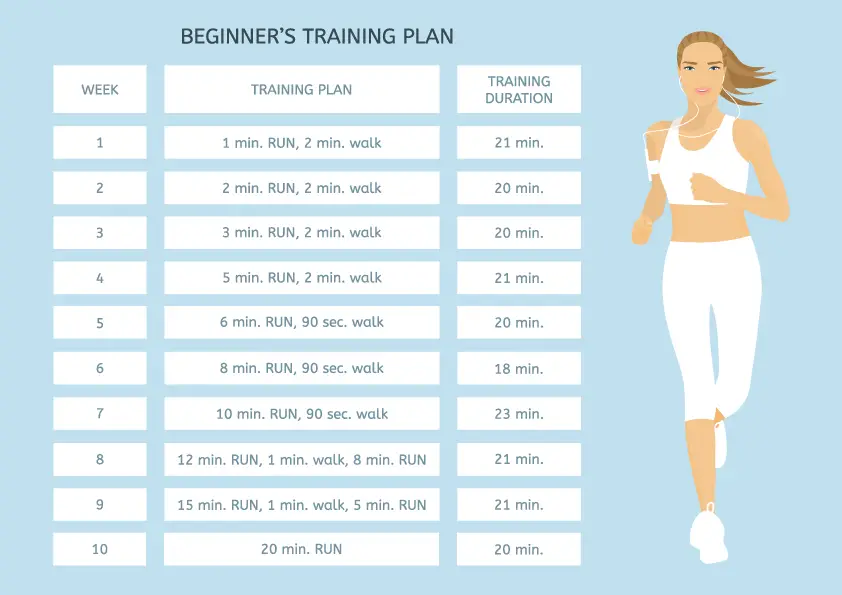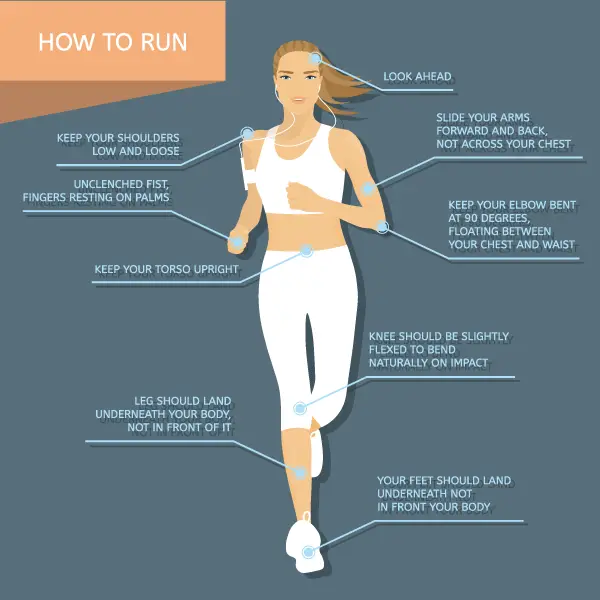There are many reasons that people decide to start running. Some people see their friends running marathons on social media and think to themselves they can do that too. Other people want to increase their health. Whereas other people view running as a simple way to stay in shape without finding time to go the gym. Regardless of why you want to become a runner, there are some running fitness beginners basic tips and processes that you will need to be aware of.
While it would be nice to run a 5K within the next few weeks, most people who are beginning runners are not going to be physically ready to take on such a challenge. Even if you are already in great physical shape, running a 5K is not the same as spending an hour on the treadmill a few times a week. It is best to ease into the world of running as a beginner to ensure that you don’t sprain anything. Physical fitness does not happen overnight regardless of what form of activity you choose.
The best way to become a runner is to have patience and work slowly but steadily towards your goal. Believe it or not, you can reach your goal with a little bit of enthusiasm and a lot of dedication and work. The following tips hit all of the major questions that will help you on your path as a new runner.
Related: Check out my YouTube Video on How Far Should New Runners Run
Getting Ready to Race
Before you sign up for a marathon, you need to stop and assess your condition as a beginner runner. When it comes to training, there are three variables that determine how you are going to perform: frequency, intensity, and duration. Other variables that also play a role are your age, gender, and overall health. These last variables you cannot control, but the first three are up to you to determine.
Before defining these variables, you need to stop and assess yourself right now by asking yourself the following 3 questions:
- How often do you run now (if at all)?
- How far can you run without becoming physically worn tired or winded?
- How fast are you able to run?
Every beginner starts somewhere. If your answers to these three variables are pretty low, don’t worry. With time you can get your stats up, but it is important to know where you are starting before you can move forward. The number one reason why most new runners get fed up with running and quit – is because they try to run too much too soon.
Now that you’ve determined your baseline you can start to work on setting and achieving your goals. More than likely you already have a goal for yourself as a runner, so keep that in mind as we take a close look at how you can reach it.
For a detailed post about the proper running form on different terrains such as flats, hills, ice/snow, sand, and trails check out Proper Running Form.
How Often Should Beginners Run?
Remember the three variables mentioned above? The first one we will look at is frequency. In order to see progress, it is widely believed that most runners need to run at least three days a week. Daily exercise in some form is of course recommended achieving maximum health benefits from your activities. If you exercise on a daily basis you lower your risk for disease, increase your lifespan, and generally are in better health than those that do not exercise. You don’t have to run every day to get these benefits, anyone who exercises in any form daily will receive them.
Cross-training
Cross-training is actually a great way to build strength in your entire body that will support your body. Runners often cross-train by incorporating walking, yoga, swimming, and biking into their weekly exercise regime. All of these sports help build endurance and yoga compliments your runs by increasing your flexibility.
However, if you choose to only run three times a week then you really need to make these three runs count. You can do this by working on the other two variables: duration and intensity. Out of the three runs you do each week you should work on one long run to help increase your endurance and two runs that focus on intensity.
If you are truly a beginner at running and exercise in general, then three runs may be a bit too aggressive to start out with. Those who are truly beginning runners may be more comfortable shooting for two regular runs a week for about 3 weeks. Starting with the fourth week you might want to add one more day in to bump your total runs to 3 times a week.
A beginner without much exercise background may need more time in between runs to rest tendons, joints, and muscles. Your muscles only rebuild when they are resting and new runners haven’t conditioned their bodies into running more frequently.
Are you looking for upright cross-training exercise bikes for runners? Check out this review on upright exercise bikes for runners.
Run 3 to 4 times per week
Most experts recommend that should run three to four times a week, however, these guidelines should be taken with caution if you are brand new to running. You will need to continuously test yourself to see which is most comfortable and matches your current fitness level. You don’t want to overdo it, but you still want to continually challenge yourself.
With this in mind, beginning runners should not try to run five to seven days a week as this will place them at great risk for injuries. Your body has to adjust to its new life as a runner, and if you continually stress it without a break you may end up with plantar fasciitis, shin splints, and other common runner’s injuries straight out the gate. It is better that you take it slow and work your way up than you end up on the sidelines before you even get started.
Related: 20 Benefits Of Running 3 Times A Week – Your Key To A Healthier Life!
How often should I take a break from running?
Your body needs time to heal in between running sessions, especially if you are new to the sport. Cross-training is a great way to get your daily exercise without overdoing it. If you are strictly running, you should aim to run at least one day on, one day off to get started. Some people may find that they perform better if they run one day on, two days off.
You will need to assess the number of breaks you need based on your physical condition and your endurance levels. When training there is always room to move your goal up slowly if you are experiencing little to no soreness, or scale it back if you find yourself incredibly sore the day after a run. You should expect a little soreness after a long run, but it should not impact the quality of your life. Any sharp, burning, or pains such as pins and needles associated with running that lasts more than 48 hours should be looked into by a medically licensed expert.
If you experience an injury then all of the above advice goes out the window. You will need to take a break from running until your doctor gives you permission to begin training again or risk an even larger injury. Injuries are the number one reason why people give up on running before they can fully engage. You can protect yourself from injury by steadily working your way towards more frequent runs instead of pushing yourself beyond your current fitness levels.
Related: Why New Runners Quit – Avoid These 15 Mistakes At All Costs!
How Far Should Beginners Run?
Now that you hopefully have a rough idea of how often you are going to run, you need to figure out how far you should run when you get started. Once again, the exact distance is going to vary based on variables such as your physical health, current conditioning level, past experiences, and overall goals. Someone who works out regularly at the gym will have a different level of physical fitness than someone who has never exercised but wants to start running.
Before deciding how far to run think about how often you have run in the past (if at all). Then consider how you felt after that run and how often you exercise on a weekly basis. If you have a running past, think about the longest distance you have ever run (which for many people may simply be the required 1 mile run in gym class) and how far you feel comfortable running right now.
After you get a handle on these factors, take a close look at your current health and ask yourself how healthy do you feel and if you are overweight. Now consider what your actual goals are, and whether you are running to improve your health or to start training to race a 5K, 10K, half marathon, or marathon. By thinking hard about all of these questions you will start to form an idea of what you want out of your runs. This is important because it will impact your daily runs.
How Long Does It Take To Become A Runner?
You’re more likely to stick to running if you have a training plan
A training plan keeps you motivated on target to accomplish your running goals. Here is a simple training plan to get you running 20 minutes in 10 weeks.

What is a Good Weekly Mileage for Beginners?
While all of that information is vital to crafting a good running plan, a lot of beginning runners just want hard numbers to work with. They don’t want to think about all of the variables, they just want to start running and want a hard goal to start with. If you are looking for a set weekly mileage chart here is sample weekly mileage starting points.
If you’ve ever set your eyes on a marathon, and you only expect to run a few miles at a time right now, then you may want to run smaller distances four days a week. With each run, you can slowly increase your distance so that you can reach your goal distance as the weeks go by.
On the other hand, if you are a true beginner to running and simply want to be able to run a mile without stopping to catch your breath, then a slower rate may suit you better. I’ve written a free detailed running plan based on your current fitness level on how to run 1 mile if you’re out of shape.
If you’re overweight and want to learn how to run you should check out my other website, plus size runner (this is a great intro to running if you’re overweight).
Gauge the Intensity of your Runs
In the first few weeks of running, you should simply be focused on the frequency and duration of your runs. Your goal right now is not to compete, it is simply to get through your runs. Once you are completing your daily runs without too much difficulty you can start thinking about the intensity of your runs.
As mentioned above, if you are running three times a week then you should have one long run and two that focus on endurance and intensity. You might consider running the same length as you have been but focus on increasing your speed. The faster you run the higher the intensity of your run.
There is a lot to be said for interval training, and once you are comfortable running it is time to take it up a notch. If you cannot tolerate increasing your speed for your entire run, attempt to increase your speed for five minutes and then slow for ten minutes before increasing your speed again.
Do I need to concentrate on speed for my first race?
Speed is optional when you’re new to running. The only time you’ll ever need to include speed work into your weekly running would be if you’re trying to accomplish finishing a race in a specific time or finishing a race within the race cut-off times. If you are curious to know how long half marathons and marathons stay open for runners check out this post: How long do marathons stay open for runners?
Rate of Perceived Exertion (RPE) is the key
RPE is a scale ranging from 1-10. One being the easiest perceived effort and 10 being the hardest perceived effort. is based on the effort of the individual. For instance, a new runner’s perceived effort of a 9 minute/mile pace might be an 8 difficulty. A seasoned runner might see a 9 minute/mile pace as a difficulty of a 4.
When you just start out running, you’re perceived effort needs to be between a 2 and 6. You’ll not need to touch on intervals until you’ve been running for about 8 weeks or more and want to increase your pace.
To determine your actual RPE you can use a treadmill or run outside on a track or park. You don’t need to be too methodical to test your RPEs. All you need is a minute or two of running to determine your current RPE. An RPE example for a new runner might look something like this
Rate of Perceived Exertion (RPE) - EXAMPLE
| RPE | Difficulty | Talk Test | Pace |
|---|---|---|---|
| 10 | All-out - Max Effort | Can't talk, out of breath | 8:00 |
| 9 | Extremely hard | one or two words at a time | 8:30 |
| 7-8 | Medium to Hard Effort (Interval) | Can speak in small sentences | 10:00 |
| 4-6 | Moderate Effort (Endurance) | can have a conversation | 12:00 |
| 2-3 | Light Effort (walking) | No problem talking | 15:00 |
| 1 | No Effort (Sitting/Standing) | No problem talking | 0:00 |
My gift to you: Your own personal RPE chart!
Print out the table below and keep this with you for reference when determining your RPE per pace. When you want to start increasing your speed and reducing your overall average pace you’ll want to refer to this chart so that you can determine how fast you should be running to exude the benefits from the efforts undertaken. This is also a great assessment to give to a running coach or a running club so that you can get help on what you should be running at and for how long. Don’t forget to update your RPE once every 3 months or so because as you run more and more you will become more fit changing your perceived effort.
| RPE | Difficulty | Talk Test | Pace |
|---|---|---|---|
| 10 | All-out - Max Effort (Sprints/Strides) | Can't talk, out of breath | |
| 9 | Extremely hard (Speedwork) | one or two words at a time | |
| 7-8 | Medium to Hard Effort (Interval/Speedwork) | Can speak in small sentences | |
| 4-6 | Moderate Effort (Endurance) | can have a conversation | |
| 2-3 | Light Effort (walking) | No problem talking | |
| 1 | No Effort (Sitting/Standing) | No problem talking |
How to increase your distance?
Everyone wants to meet their goals, but you need to slowly increase your distance if you want to keep your goal attainable. It is usually wiser to consider increasing your distance before increasing the number of runs you do each week. This allows your body the same cooling down period but allows you to push a bit harder.
Instead of focusing on adding measurable distance to your run such as half a mile more, consider adding more time to your run. Choose one run per week to add another five to ten minutes onto. This means that you will be doing one long run each week. Depending on the length of your current run this might only be another mile or so, but it will help increase your endurance.
Once you are comfortable with the longer length one time a week, consider making your other two runs the same length. Continually run at an increased length until this daily length becomes your new normal. Once it does, you can increase one run a week by an additional five to ten minutes. Over the next few months/years of running, you can slowly continue to increase your running length until you reach your distance goals without any struggle.
When to back off or slow down?
As a general rule of thumb, beginning runners should never attempt to increase their time or mileage by more than ten perfect at any point. Your body needs time to adjust to any changes that you make, and while some people like to believe its mind over matters when it comes to physical injuries If this is not the case.
Avoiding injury
You want to avoid injuries and burnout, and the best way to do this is by adding a small amount of time to your runs each week. If the idea of every run fills you with dread, you will likely burn out before you ever get close to reaching your goal. Beginning runners often push themselves too hard in an effort to obtain elite status, but this rarely works out. If you find yourself chasing outlandish goals or comparing yourself to others check this post – 6 things running coaches wish you would stop doing.
You should enjoy running
Running should always be enjoyable, if it starts to feel draining or too intense then it may be time to back off a little bit and relax on your body. Fatigue can be tricky because sometimes you feel the results right after a run and sometimes you feel it two weeks into a new daily regime. Either way, you need to learn to trust the signals that your body is sending you.
In general, you should back off or slow down if:
- You feel tired more than a couple of days a week
- Your legs feel like dead weight even after a warm-up
- You’re struggling at a pace that is usually obtainable for you
- You simply feel ‘off’ during a run
- You start feeling burnt out or stressed about running
Related: How Do I Know If I’m Overtraining?
Timed Running vs. Distance Running?
As a beginning runner, you will have the choice to plan your runs based on distance or time. It is usually easier to time your runs than track them by distance, but in the end, the way you choose to record them is of little significance.
Tracking distance is usually a bit more quantitative and gives you the information you need if you are training for a long race such as a half or full marathon, but they can lead to you switching your intensity quite often as you attempt to reach your goal. Timed goals tend to result in a much smoother running pace. This same perceived effort (conversation pace) is what you will use for 100% of your weekly long runs that can help you build a solid base for running.
Measuring your runs
It is up to you to measure your runs as you see fit, but if you have a lot of scheduling conflicts, at least as a starting point timed runs may be a bit easier to fit into your schedule than distance runs. When you set a goal of X minutes every day you know exactly how long you will be running. This can make it easier to get a daily run in. If you set distance goals, you may quickly find that they don’t fit into your schedule.
The point of running is to run. You should measure your runs based on what will help you reach that goal. How you measure your runs will be of little consequence if you don’t actually get out there and run. If you’re having trouble motivating yourself into running take a look at this post about – 5 easy ways to trick your mind into running.
How Many Miles a Week Should I Run for Health Reasons?
If you are solely running to increase your health, you may be pleasantly surprised to hear that the minimum goal is not too high. In reality, running about half a mile a day for six to seven days a week is all you need. Of course, you likely aren’t going to be running every day, but that means if you run a mile three days a week you will reach your health goal.
As you start to feel better and become a faster runner, you can start to exceed this goal and receive even more health benefits from daily exercise. A mile a few times a week is a very attainable goal for most, and something that you can eventually hope to complete in 10-12 minutes a few times a week. If you are scheduling in 20 minutes a week for exercise, you can easily exceed your goal over time.
“For optimal health, it is recommended that adults obtain at least 150 min per week of moderate-intensity or 75 min per week of vigorous-intensity aerobic exercise per week” (US Physical Activity Guidelines: Current state, impact and future directions, Eugene H. Chung)
Referring back to the RPE chart below, you should be exercising with moderate intensity (150 minutes) which is a 4-6 RPE or vigorous-intensity (75 minutes) which is a 7+ RPE weekly. If you run 5 times a week for 30 minutes you’ve met your 150-minute guideline for moderate-intensity exercise.
Rate of Perceived Exertion (RPE) - EXAMPLE
| RPE | Difficulty | Talk Test | Pace |
|---|---|---|---|
| 10 | All-out - Max Effort | Can't talk, out of breath | 8:00 |
| 9 | Extremely hard | one or two words at a time | 8:30 |
| 7-8 | Medium to Hard Effort (Interval) | Can speak in small sentences | 10:00 |
| 4-6 | Moderate Effort (Endurance) | can have a conversation | 12:00 |
| 2-3 | Light Effort (walking) | No problem talking | 15:00 |
| 1 | No Effort (Sitting/Standing) | No problem talking | 0:00 |
When Will I See the Benefits of Daily Running?
While you may feel good after your first few runs, your body will not actually start to attain the benefits of a regular running routine until at least two weeks if not longer. Those who are training for long endurance runs may not see the benefits until 4 to 6 weeks have passed. For others, it could take up to 9 or 10 weeks until any benefits are seen.
This is because while you are feeling the effects on your body, it takes almost four to six weeks before your aerobic ability and training effects are actually realized. If you are already in good physical shape, it can actually take you a bit longer to notice any chances because your aerobic system is already at a higher point than someone who just started.
Even if you don’t directly feel the benefits of a daily run, you should keep pressing forward because the health benefits are there. As mentioned earlier, runners are less prone to disease and tend to have longer lifespans than those that led sedentary lives.
Outside of aerobic enhancement, many people who run outdoors often report that their mental capabilities and overall mood benefits almost immediately because of the experience of being outdoors. I do all of my deepest thinking when I’m out on a run. I see things with more clarity and I can really dig deep on issues at hand.
In today’s world, most people don’t have time to slow down and enjoy nature, becoming an outdoor athlete allows for this experience to become real again.

What do you do if you REALLY struggle with running?
New runners have a great desire to start running, get in shape, and stick to it so a habit can be formed. Something usually happens around the second or third week as to why runners give up. One of the biggest problems for new runners is an incorrect perception of the sport of running. Most runners you see in parks, on your neighborhood streets, and at races are seasoned runners. They’ve put in the time, ran for months if not years, and stuck with it.
From my experience as a runner and a running coach new runners make these two big mistakes:
- Runners try to run too much or too far too soon – they end up getting hurt or just figure it’s too hard and give up.
- New runners take longer to see any benefit from running – sometimes it can take 5 to 6 weeks before a new runner will see any benefit from running. It depends on the current condition of the new runner.
I try to explain to new runners that it can easily take 6 to 7 weeks before some new runners can run one mile without stopping. The trick is to not give up too early.
If you’re struggling with running check my detailed post about – why is running so hard – 35 ways to make your runs easier.
Is Walking the Same as Running?
When strictly measuring health benefits walking and running can be level based on the overall distance. Walking one mile will have about the same health benefits as running one mile, but running a mile is quicker. Therefore, a walker can never hope to achieve the same benefits to their endurance level and overall aerobic activity as a runner because walking 6 miles a day is not as achievable as running six miles per day.
There is no shame in walking
Using a walk/run interval training system you can teach yourself to run slowly, to make sure that you don’t get injured. Many runners that start off later in life use this technique to help to train your body to start running by including walks in between your short running intervals. Ultra runners even use run/walk techniques during training and also during long races such as 50 milers and 100 milers.
For more detailed information about walking half marathons check out my post – can you walk a half marathon in 4 hours? (This post gives you pacing charts based on when you want to finish).
Related: 22 Running Tips For Absolute Beginners!
| Help support me and subscribe to my YouTube channel. YouTube video - 30 ways to make your runs less painful! Coach Scott's Credentials:
|
To sign up for a FREE half marathon training schedule, log sheet, and pace predictor CLICK HERE.

Recommended gear for runners
Connect with me:
| facebook.com/BeginnerToFinisher/ |



6 thoughts on “How far should I run as a beginner runner?”